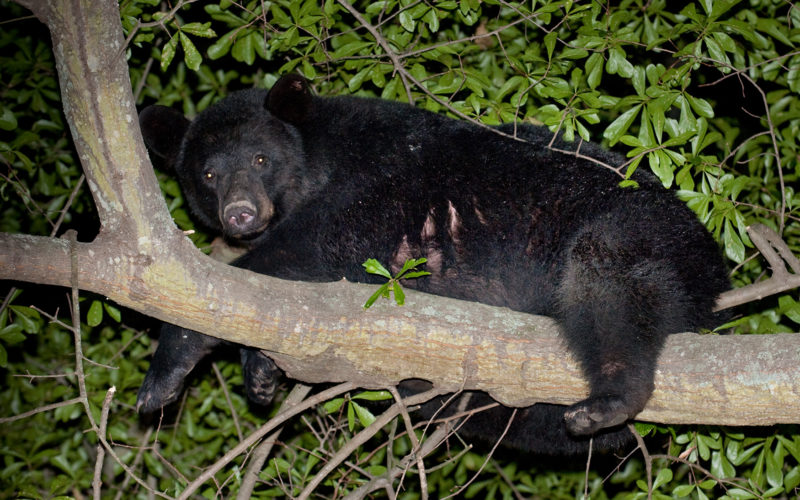Wandering bears just trying to live their lives
AMANDA BANCROFT
Making Ripples
Glimpse the wild in an unexpected place, and it transforms that place. Deer cross roads, foxes den in yards, raccoons appear on the back porch. Maybe an unseen bobcat will walk down our driveway the moment we close the curtains for the night! One square of sidewalk is infinitely changing, transformed by the colorful flight of butterflies, leaves blown by a gust of wind, or the padded paws of a black bear walking near the Fayetteville Public Library. We can continue to enjoy these glimpses by learning what to do to keep ourselves and wildlife safe during encounters.
Before Arkansas was known as “The Natural State,” it was informally referred to as “The Bear State” because we had so many black bears. It’s not hard to believe that there are 5,000 to 6,000 black bears in Arkansas, and that includes a healthy population in Washington County, according to the Arkansas Game and Fish Commission. Within the past month or so, people have spotted black bears in Fayetteville, Farmington, Ozark and in northeastern Arkansas where the famous Bruno the Bear was seen.

This black bear strolled through Arkadelphia several years ago, stopping at a convenience store and a couple of fast-food restaurants before heading to Henderson State University, where it was photographed taking a rest in a tree. Black bears are frequently seen in Arkansas, and the best reaction is to not crowd them, not feed them and not try to pet them.
(File Photo)
Bruno, who is recognized by his ear tags, began his journey near Warrens, Wis. Wildlife biologists in several states have offered possibilities for why he’s traveled so far: to find a mate, establish a territory or perhaps because he got disoriented and is lost. He walked south through Illinois, Iowa, swam across the Mississippi River into Missouri, and was last seen in Lawrence County, Arkansas, as of this writing. That’s a journey of more than 700 miles! If you’d like to follow Bruno, the Facebook group “Keeping Bruno Safe” has 168,462 members and lots of photos.
The best way to help is to not crowd bears, feed them or touch them. Black bears are not a threat to humans and pets, and attacks are extremely rare. As omnivores, they mostly eat berries, seeds, insects and wild foods – not livestock or dogs. If you surprise a bear accidentally, do not run. Bears can run faster than humans. Make lots of noise and back away slowly. Always give wildlife lots of space — stay at least 100 yards away from black bears.
If you hear of a black bear in the area, it can help the bear if you remove any bird feeders temporarily. We need bears to be afraid of humans and not see human habitation as food sources, because they quickly become so-called nuisance animals and people will call the police. “A fed bear is a dead bear.” You can also help increase the number of bear-aware people by sharing this information online and in person.
It’s better to let bears keep moving and go about their business rather than call authorities to come tranquilize and relocate them, but if you do see a bear in a heavily populated area (such as downtown) it may save its life and keep our fellow humans safe to report the bear to the Arkansas Game and Fish Commission at 800-482-9262. If you think the bear can leave safely on its own, keep its location to yourself (to avoid drawing uninformed crowds) and just enjoy our ever-changing wild urban spaces.
Amanda Bancroft is a writer, artist, and naturalist living in an off-grid tiny house on Kessler Mountain. She and her husband Ryan blog about their adventures and offer tips to those wanting to make a difference at www.RipplesBlog.org.










